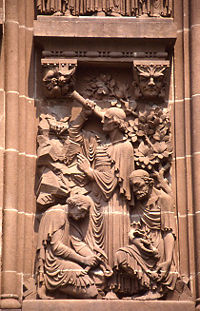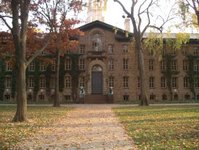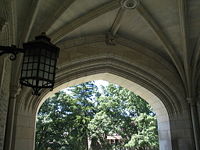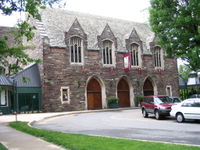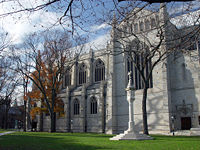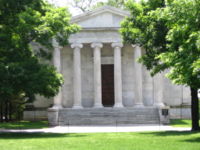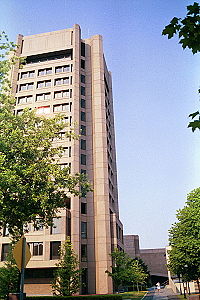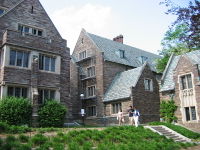Princeton University
2008/9 Schools Wikipedia Selection. Related subjects: Education
| Princeton University | |
|---|---|
 |
|
|
|
|
| Motto: | Dei sub numine viget (Latin) |
| Motto in English: | Under God's power she flourishes |
| Established: | 1746 |
| Type: | Private |
| Endowment: | US$15.8 billion |
| President: | Shirley M. Tilghman |
| Staff: | 1,103 |
| Undergraduates: | 4,923 |
| Postgraduates: | 1,975 |
| Location: | Princeton Township, and West Windsor Township, New Jersey, USA |
| Campus: | Suburban, 600 acres (2.4 km²) (Princeton Borough and Township) |
| Athletics: | 38 sports teams |
| Colors: | Orange and Black |
| Mascot: | Tigers |
| Affiliations: | MAISA; AAU |
| Website: | www.princeton.edu |
Princeton University is a private coeducational research university located in Princeton, New Jersey. It is one of the eight universities that belong to the Ivy League.
Originally founded at Elizabeth, New Jersey, in 1746 as the College of New Jersey, it moved to Princeton in 1756 and was renamed “Princeton University” in 1896. Princeton was the fourth institution of higher education in the U.S. to conduct classes. Princeton has never had any official religious affiliation, rare among American universities of its age. At one time, it had close ties to the Presbyterian Church, but today it is nonsectarian and makes no religious demands on its students. The university has ties with the Institute for Advanced Study, Princeton Theological Seminary and the Westminster Choir College of Rider University.
Princeton has traditionally focused on undergraduate education, though it also has a small number of graduate students. Although lacking medical, law, or business schools, it offers professional master's degrees (mostly through the Wilson School) and doctoral programs in the sciences, humanities, and social sciences. In addition to the research conducted on the main campus, the Forrestal Campus has special facilities for the study of plasma physics and meteorology.
History
The history of Princeton goes back to its establishment by " New Light" Presbyterians; Princeton was originally intended to train Presbyterian ministers. It opened at Elizabeth, New Jersey, under the presidency of Jonathan Dickinson as the College of New Jersey. Its second president was Aaron Burr, Sr.; the third was Jonathan Edwards. In 1756, the college moved to Princeton, New Jersey.
Between the time of the move to Princeton in 1756 and the construction of Stanhope Hall in 1803, the college's sole building was Nassau Hall, named for the Dutch William III of England of the House of Orange-Nassau. (A proposal was made to name it for the colonial Governor, Jonathan Belcher, but he declined.) The college also got one of its colors, orange, from William III. During the American Revolution, Princeton was occupied by both sides, and the college's buildings were heavily damaged. The Battle of Princeton, fought in a nearby field in January of 1777, proved to be a decisive victory for General George Washington and his troops. Two of Princeton's leading citizens signed the United States Declaration of Independence, and during the summer of 1783, the Continental Congress met in Nassau Hall, making Princeton the country's capital for four months. The much-abused landmark survived bombardment with cannonballs in the Revolutionary War when General Washington struggled to wrest the building from British control, as well as later fires that left only its walls standing in 1802 and 1855. Rebuilt by Joseph Henry Latrobe, John Notman, and John Witherspoon, the modern Nassau Hall has been much revised and expanded from the original designed by Robert Smith. Over the centuries, its role shifted from an all-purpose building, comprising office, dormitory, library, and classroom space, to classrooms only, to its present role as the administrative centre of the university. Originally, the sculptures in front of the building were lions, as a gift in 1879. These were later replaced with tigers in 1911.
The Princeton Theological Seminary broke off from the college in 1812, since the Presbyterians wanted their ministers to have more theological training, while the faculty and students would have been content with less. This reduced the student body and the external support for Princeton for some time. The two institutions currently enjoy a close relationship based on common history and shared resources.
President James McCosh took office in 1868, lifting the university out of a low period brought on by the Civil War. During his two decades in power, he overhauled the curriculum, oversaw an expansion of inquiry into the sciences, and supervised the addition of a number of buildings in the High Victorian Gothic style to the campus. McCosh Hall is named in his honour.
In 1896, the college officially changed its name from the College of New Jersey to Princeton University to honour the town in which it resided. During this year, the college also underwent large expansion and officially became a university. Under Woodrow Wilson, Princeton introduced the preceptorial system in 1905, a then-unique concept that augmented the standard lecture method of teaching with a more personal form where small groups of students, or precepts, could interact with a single instructor, or preceptor, in their field of interest.
In 1969, Princeton University first admitted women as undergraduates. In 1887, the university had actually maintained and staffed a sister college in the town of Princeton on Evelyn and Nassau streets, called the Evelyn College for Women, which was closed after roughly a decade of operation. After abortive discussions in 1967 with Sarah Lawrence College to relocate the women's college to Princeton and merge it with the university, the administration decided to admit women and turned to the issue of transforming the school's operations and facilities into a female-friendly campus. The administration barely finished these plans by April 1969 when the admission's office began mailing out its acceptance letters. Its five-year coeducation plan provided $7.8 million for the development of new facilities that would eventually house and educate 650 women students at Princeton by 1974. Ultimately, 148 women, consisting of 100 freshwomen and transfer students of other years, entered Princeton on September 6, 1969 amidst much media attention. (Princeton enrolled its first female graduate student, Sabra Follett Meserve, as a Ph.D. candidate in Turkish history in 1961. A handful of women had studied at Princeton as undergraduates from 1963 on, spending their junior year there to study subjects in which Princeton's offerings surpassed those of their home institutions. They were considered regular students for their year on campus, but were not candidates for a Princeton degree.)
Campus
Princeton's campus features buildings designed by noted architects such as Benjamin Latrobe, Ralph Adams Cram, McKim, Mead & White, Robert Venturi, and Nick Yeager. The campus, located on 2 km² of landscaped grounds, features a large number of Neo-gothic-style buildings, most dating from the late 19th and early 20th centuries. It is situated about one hour from New York City and Philadelphia. The first Princeton building constructed was Nassau Hall, situated in the north end of Campus on Nassau Street. Stanhope Hall (once a library, now home of the University's Centre for African-American Studies) and East and West College, both dormitories, followed. While many of the succeeding buildings—particularly the dormitories of the Northern campus—were built in a Collegiate Gothic style, the university is something of a mixture of American architectural movements. Greek Revival temples (Whig and Clio Halls) abut the lawn south of Nassau Hall, while a crenellated theatre (Murray-Dodge) guards the route west to the library. Modern buildings are confined to the east and south of the campus, a quarter overlooked by the 14-story Fine Hall. Fine, the Math Department's home, designed by Warner, Burns, Toan and Lunde and completed in 1970, is the tallest building at the university. Contemporary additions feature a number of big-name architects, including IM Pei's Spelman Halls, Robert Venturi's Frist Campus Centre, Rafael Vinoly's Carl Icahn Laboratory, the Hillier Group's Bowen Hall, and Demetri Porphyrios' Whitman College. A science library by Frank Gehry is under construction. Much sculpture adorns the campus, including pieces by Henry Moore (Oval with Points, also nicknamed "Nixon's Nose"), Clement Meadmore (Upstart II), and Alexander Calder (Five Disks: One Empty). At the base of campus is the Delaware and Raritan Canal, dating from 1830, and Lake Carnegie, a man-made lake donated by the steel magnate Andrew Carnegie, used for crew (rowing) and sailing.
Cannon Green
Cannon Green is located on the south end of the main lawn. Buried in the ground at the centre is the "Big Cannon", the top of which protrudes from the earth and is traditionally spray-painted in orange with the current senior class year. A second "Little Cannon" is buried in the lawn in front of nearby Whig Hall. Both were buried in response to periodic thefts by Rutgers students. The "Big Cannon" is said to have been left in Princeton by Hessians after the Revolutionary War but moved to New Brunswick during the War of 1812. Ownership of the cannon was disputed and the cannon was eventually taken back to Princeton partly by a military company and then by 100 Princeton students. The "Big Cannon" was eventually buried in its current location behind Nassau Hall in 1840. In 1875, Rutgers students attempting to recover the original cannon stole the "Little Cannon" instead. The smaller cannon was subsequently recovered and buried as well. The protruding cannons are occasionally painted scarlet by Rutgers students who continue the traditional dispute.
The Academy Award-winning movie, A Beautiful Mind, contains a scene on Cannon Green. John Nash plays Go with his college rival while sitting on stone benches in the middle of the green. (The benches do not exist; like many elements of the Princeton setting, they were introduced for the film.) Additional scenes were filmed around Holder Courtyard.
Buildings
McCarter Theatre
The Tony-award-winning McCarter Theatre was built by the Princeton Triangle Club using club profits and a gift from Princeton University alumnus Thomas McCarter. Today the Triangle Club is an official student group and performs its annual freshmen revue and fall musicals in McCarter. The McCarter is also recognized as one of the leading regional theaters in the United States.
Art Museum
The Princeton University Art Museum was established to give students direct, intimate, and sustained access to original works of art to complement and enrich instruction and research at the university, and this continues to be its primary function.
Numbering nearly 60,000 objects, the collections range chronologically from ancient to contemporary art, and concentrate geographically on the Mediterranean regions, Western Europe, China, the United States, and Latin America. There is a collection of Greek and Roman antiquities, including ceramics, marbles, bronzes, and Roman mosaics from Princeton University’s excavations in Antioch. Medieval Europe is represented by sculpture, metalwork, and stained glass. The collection of Western European paintings includes examples from the early Renaissance through the nineteenth century, and there is a growing collection of twentieth-century and contemporary art.
Among the strengths in the museum are the collections of Chinese art, with important holdings in bronzes, tomb figurines, painting, and calligraphy; and pre-Columbian art, with examples of the art of the Maya. The museum has collections of old master prints and drawings and a comprehensive collection of original photographs. African art is represented as well as Northwest Coast Indian art. Other works include those of the John B. Putnam, Jr., Memorial Collection of twentieth-century sculpture, including works by such modern masters as Alexander Calder, Jacques Lipchitz, Henry Moore and Pablo Picasso. The Putnam Collection is overseen by the Museum but exhibited outdoors around campus.
University Chapel
Princeton University Chapel is the third-largest university chapel in the world. Known for its gothic architecture, the chapel houses one of the largest and most precious stained glass collections in the country. Both the Opening Exercises for entering freshmen and the Baccalaureate Service for graduating seniors take place in the University Chapel. Construction on the Princeton University Chapel began in 1924 was completed in 1927, at a cost of $2.4 million. Princeton's Chapel is the world's third-largest university chapel, behind those of Valparaiso University and King's College, Cambridge, England. It was designed by the University's lead consulting architect, Ralph Adams Cram, previously of Boston's architectural firm Cram, Goodhue and Ferguson, leading proponents of the Gothic revival style. The vaulting was built by the Guastavino Company, whose thin Spanish tile vaults can be found in Ellis Island, Grand Central Terminal, and hundreds of other significant works of 20th century architecture.
The 270-foot-long, 76-foot-high, cruciform church is in the collegiate Gothic style, and is made largely from Pennsylvania sandstone and Indiana limestone. It seats 2000 people, many in pews made from wood salvaged from Civil War-era gun carriages. Seats in the chancel are made from oak from Sherwood Forest. The 16th century pulpit was brought from France and the primary pipe organ has 8000 pipes and 109 stops.
One of the most prominent features of the chapel is its stained glass windows which have an unusually academic leaning. Three of the large windows have religious themes: the north aisle windows shows the life of Jesus, the north clerestory shows the spirtual development of the Jews, while the south aisle has the teachings of Jesus. The stained glass in the south clerestory portrays the evolution of human thought from the Greeks to modern times. It has windows on such topics as Science, Law, Poetry and War.
Organization
Princeton is among the wealthiest universities in the world, with an endowment of US$15.8 billion. Ranked as the fourth largest endowment in the United States, the university has the greatest per-student endowment in the world. This is sustained through the continued donations of its alumni and is maintained by investment advisors. Some of Princeton's wealth is invested in its art museum, which features works by Claude Monet and Andy Warhol, among other prominent artists.

University housing is guaranteed to all undergraduates for all four years, and more than 95 percent of students live on campus in dormitories. Freshmen and sophomores live in residential colleges. Juniors and seniors have the option to live off-campus, but high rent in the Princeton area encourages almost all students to live in dorms. Undergraduate social life revolves around the residential colleges and a number of coeducational " eating clubs", which students may choose to join at the end of their sophomore year. Eating clubs serve as dining halls and communal spaces for their members and also host a number of social events throughout the academic year.
Princeton has six undergraduate residential colleges, each housing approximately 500 freshmen, sophomores, and a handful of junior and senior resident advisers. Each college consists of a set of dormitories, a dining hall, a variety of other amenities — such as study spaces, libraries, performance spaces, and darkrooms — and a collection of administrators and associated faculty. Two colleges, Wilson College and Forbes College (formerly Princeton Inn College), date to the 1970s; three others, Rockefeller, Mathey, and Butler Colleges, were created in 1983 following the Committee on Undergraduate Residential Life (CURL) report suggesting colleges as a solution to a perception of fragmented campus social life. The construction of Whitman College, the university's sixth, was completed in 2007.
Rockefeller College and Mathey College are located in the northwest corner of the campus; their Collegiate Gothic architecture often graces University brochures. Like most of Princeton's Gothic buildings, they predate the residential college system and were fashioned into colleges from individual dormitories.
Wilson College and Butler College, located south of the centre of the campus, were built in the 1960s, with Wilson serving as an early experiment in Residential Colleges. Butler, like Rockefeller and Mathey, was a collection of ordinary dorms (called the "New New Quad") before the addition of a dining hall made it a residential college. Widely disliked for its edgy modernist design, the dormitories on the Butler Quad were demolished in 2007, and the college is being partially housed in converted upperclass dormitories until its reconstruction is completed. The new Butler buildings will be designed in the modern style again for fear of a sharp clashing with the modern math and science buildings in proximity to the new Quad.
Forbes College, located slightly beyond the southwest corner of the campus, is a former hotel, purchased by the university and expanded to form a residential college. The "Princeton Inn College" was one of the first residential colleges in the 1970s along with Wilson College. Butler and most of Forbes are in a different municipality, Princeton Township, from the rest of the main campus, which is in Princeton Borough.
In 2003, Princeton broke ground for a sixth college, named Whitman College after its principal sponsor, Meg Whitman, the former CEO of eBay and a member of the Princeton Class of 1977. The new dormitories were constructed in the neo-Gothic architectural style and were designed by renowned architect Demetri Porphyrios. Construction finished in 2007, and Whitman College was inaugurated as Princeton's sixth residential college that year.
A variant on the present college system was originally proposed by University President Woodrow Wilson in the early twentieth century. Wilson's model was much closer to Yale's present system, which features four-year colleges. Lacking the support of the Trustees, the plan languished until 1968, when Wilson College was established, capping a series of alternatives to the eating clubs. A series of often fierce debates raged before the present underclass-college system emerged. The plan was first attempted at Yale, but the administration was initially uninterested; an exasperated alum, Edward Harkness, finally paid to have the college system implemented at Harvard in the 1920s, leading to the oft-quoted aphorism that the college system is a Princeton idea done at Harvard with Yale's money.
Princeton has one graduate residential college, known simply as the Graduate College, located beyond Forbes College at the outskirts of campus. The far-flung location of the G.C. was the spoil of a squabble between Woodrow Wilson and then-Graduate School Dean Andrew Fleming West, which the latter won. (Wilson preferred a central location for the College; West wanted the graduate students as far as possible from the campus.) The G.C. is composed of a large Collegiate Gothic section crowned by Cleveland Tower, a local landmark that also houses a world-class carillon. The attached New Graduate College houses more students. Its design departs from collegiate gothic, and is reminiscent of Butler College, the newest of the five pre-Whitman undergraduate colleges.
Academics
Princeton offers two main undergraduate degrees: the Bachelor of Arts (A.B.) and the Bachelor of Science in engineering (B.S.E.). Courses in the humanities are traditionally either seminars or semi-weekly lectures with an additional discussion seminar, called a "precept" (short for "preceptorial"). To graduate, all A.B. candidates must complete a senior thesis and one or two extensive pieces of independent research, known as "junior papers" or "J.P.s." Juniors in some departments, including architecture and the creative arts, complete independent projects that differ from written research papers. A.B. candidates must also fulfill a two-semester foreign language requirement and distribution requirements with a total of 31 classes. B.S.E. candidates follow a parallel track with an emphasis on a rigorous science and math curriculum, a computer science requirement, and at least two semesters of independent research including an optional senior thesis. All B.S.E. students must complete at least 36 classes. A.B. candidates typically have more freedom in course selection than B.S.E. candidates because of the fewer number of required classes, though both enjoy a comparatively high degree of latitude in creating a self-structured curriculum.
Undergraduates at Princeton University agree to conform to an academic honesty policy called the Honour Code. Students write and sign the honor pledge, "I pledge my honor that I have not violated the Honor Code during this examination," on every in-class exam they take at Princeton. (The form of the pledge was changed slightly in 1980; it formerly read, "I pledge my honor that during this examination, I have neither given nor received assistance.") The Code carries a second obligation: upon matriculation, every student pledges to report any suspected cheating to the student-run Honor Committee. Because of this code, students take all tests unsupervised by faculty members. Violations of the Honor Code incur the strongest of disciplinary actions, including suspension and expulsion. Out-of-class exercises are outside the Honour Committee's jurisdiction. In these cases, students are often expected to sign a pledge on their papers that they have not plagiarized their work ("This paper represents my own work in accordance with University regulations."), and allegations of academic violations are heard by the University Committee on Discipline.
Princeton offers postgraduate research degrees in mathematics, physics, astronomy and plasma physics, economics, geosciences, history, political science, philosophy, and English. Although Princeton offers professional graduate degrees in engineering, architecture, and finance, it has no medical school, law school, or business school like other research universities. Its most famous professional school is the Woodrow Wilson School of Public and International Affairs, founded in 1930 as the School of Public and International Affairs and renamed in 1948.
The university's library system houses over eleven million holdings including six million bound volumes; The main university library, Firestone Library, housing almost four million volumes, is one of the largest university libraries in the world (and among the largest "open stack" libraries in existence). Its collections include the Blickling homilies. In addition to Firestone, many individual disciplines have their own libraries, including architecture, art history, East Asian studies, engineering, geology, international affairs and public policy, and Near Eastern studies. Seniors in some departments can register for enclosed carrels in the main library for workspace and the private storage of books and research materials. In February 2007, Princeton became the 12th major library system to join Google's ambitious project to scan the world's great literary works and make them searchable over the Web.
Princeton is one of the most selective colleges in the United States, admitting only 9.25% of undergraduate applicants in 2008. In September 2006, Princeton University announced that all applicants for the Class of 2012 would be considered in a single pool, effectively ending the Early Decision program. In 2001, Princeton was the first university to eliminate loans for all students who qualify for aid, expanding on earlier reforms. U.S. News & World Report and Princeton Review both cite Princeton as having the fewest number of students graduating with debt even though 60% of incoming students are on some type of financial aid. The Office of Financial Aid estimates that Princeton seniors on aid will graduate with average indebtedness of $2,360, compared to the national average of about $20,000.
Rankings
From 2001 to 2008, Princeton University has been ranked first among national universities by U.S. News and World Report (USNWR). Among other outlets, Princeton ranked eighth among world universities by Shanghai Jiao Tong University, sixth among world universities and third in North America by THES - QS World University Rankings.
Princeton University also participates in the National Association of Independent Colleges and Universities ( NAICU)'s University and College Accountability Network (U-CAN).
See also List of Princeton University people#Notable Princeton professors.
Princeton University has an IBM BlueGeneL supercomputer, called Orangena, which was 79th fastest in the world in 2005 ( LINPACK performance of 4713; compared to 12250 for other U. S. universities and 280600 for the top-ranked supercomputer, belonging to the U. S. Department of Energy).
Student life and culture
Princeton hosts two Model United Nations conferences, PMUNC in the fall for high school students and PICSim in the spring for college students. It also hosts the Princeton Invitational Speech and Debate tournament each year at the end of November.
Princeton also runs Princeton Model Congress, held once a year in mid-November. The 4-day conference is for high school students from around the country and the fierce competition gives the conference its prestige.
Each residential college hosts social events and activities, guest speakers (such as Edward Norton, who showed a special sneak-preview of Fight Club on campus), and trips. The residential colleges are best known for their performing arts trips to New York City. Students sign up to take trips to see the ballet, the opera, Broadway shows, sports events, and other activities.
The eating clubs are co-ed organizations for upperclassmen located on the east end of campus. Most upperclassmen eat their meals at one of the 10 eating clubs, whose houses also serve as evening and weekend social venues for members and guests.
Although the school's admissions policy is " need-blind" Princeton was ranked near the bottom (based on the proportion of students receiving Pell Grants) in economic diversity among all national universities ranked by U.S. News & World Report. However, this statistic is potentially misleading, as the university offers its own aid in the form of grants. The rankings article cautions that "the proportion of students on Pell Grants isn't a perfect measure of an institution's efforts to achieve economic diversity."
- Arch Sings - Free late-night concerts in one of the larger arches on campus offered by one or several of Princeton's thirteen undergraduate a cappella groups. Most often held in Blair Arch or Class of 1879 Arch.
- Bonfire - ceremonial bonfire on Cannon Green behind Nassau Hall, held only if Princeton beats both Harvard and Yale at football in the same season; the most recent bonfire was lit November 17, 2006, after a 12-year drought.
- Bicker - Selection process for new-members employed by selective eating clubs
- Cane Spree - an athletic competition between freshmen and sophomores held in the fall
- The Clapper or Clapper Theft - climbing to the top of Nassau Hall and stealing the bell clapper so as to prevent the bell from ringing and, thus, from starting class on the first day of the school year. For safety reasons, the clapper has now been removed permanently.
- Class Jackets (Beer Jackets) - Each graduating class (and each class at its multiple-of-5 reunion thereafter—5th, 10th, etc.) designs a Class Jacket featuring their class year. The artwork is almost invariably dominated by the school colors and tiger motifs.
- Communiversity - an annual street fair with performances, arts and crafts, and other activities in an attempt to foster interaction between the university and residents of the Princeton community
- Dean's Date Theatre - tradition of gathering late in the afternoon on the final deadline for written work for the semester ("Dean's Date") outside McCosh Hall to watch other students run to hand in their papers. Some students perform cartwheels and other antics (if they are not running too late).
- FitzRandolph Gate - at the end of Princeton's graduation ceremony, the new graduates process out through the main gate of the university as a symbol of their leaving college and entering the real world. According to tradition, anyone who leaves campus through FitzRandolph Gate before his or her own graduation date will not graduate (though entering through the gate is fine).
- Holder Howl - The midnight before Dean's Date (when most final papers and assignments are due) students from Holder Hall and elsewhere come to the Holder courtyard and "howl" to release the frustration of last-minute work on their assignments.
- Houseparties - formal parties thrown simultaneously by all of the eating clubs at the end of the spring term
- Lawnparties - parties with live bands thrown simultaneously by all of the eating clubs at the start of classes and conclusion of the year.
- Locomotive - chant traditionally used by Princetonians to acknowledge a particular year or class. Goes: "Hip... hip... rah rah rah tiger tiger tiger sis sis sis boom boom boom bah!" followed by three chants of the class which is being acknowledged. Commonly heard at Opening Exercises in the fall, as alumni and current students welcome the freshman class.
- Newman's Day - Students attempt to drink 24 beers in the 24 hours of April 24. According to the New York Times, "the day got its name from an apocryphal quote attributed to Mr. Newman: '24 beers in a case, 24 hours in a day. Coincidence? I think not.'" Newman has spoken out against the tradition, however.
- Nude Olympics - annual (nude and partially nude) frolic in Holder Courtyard during the first snow of the winter. Started in the early 1970s, the Nude Olympics went co-ed in 1979 and gained much notoriety with the American press. For safety reasons, the administration banned the Olympics in 2000.
- Prospect 11 - referring to the act of drinking a beer at all eleven eating clubs on The Street in one night. With the recent closure of Campus Club, this has become impossible and has been replaced by the Prospect 10; however, the historical Cannon Club is due to reopen in Spring 2008, and the Prospect 11 will return.
- P-rade - traditional parade of alumni and their families, who process by class year, during Reunions
- Reunions - annual gathering of alumni, held the weekend before graduation
- The Phantom of Fine Hall - a former tradition - before 1993, this was the legend of an obscure, shadowy figure that would infest Fine Hall (the Mathematics department's building) and write complex equations on blackboards. Although mentioned in Rebecca Goldstein's 1980s book The Mind-Body Problem about Princeton graduate student life (Penguin, reissued 1993), the legend self-deconstructed in the 1990s when the Phantom turned out to be in reality the inventor, in the 1950s, of the Nash equilibrium result in game theory, John Forbes Nash. The former Phantom, by then also haunting the computation centre where courtesy of handlers in the math department he was a sacred monster with a guest account, shared the 1994 Nobel Prize and is now a recognized member of the University community. (Unlike the book, the film version of A Beautiful Mind does not attempt to be factual; its screenwriter called it "a stab at the truth… but not by way of the facts.")
Athletics
The Princeton Review (unaffiliated with the university) declared Princeton the 10th strongest "jock school" in the nation. It has also consistently been ranked at the top of TIME's "Strongest College Sports Teams" lists. Most recently, Princeton was ranked as a top 10 school for athletics by Sports Illustrated. Princeton is well known for its men and women's crews, winning several NCAA and Eastern Sprints titles in recent years.
Princeton won a record 21 conference titles from 2000–2001. By the end of 2004, Princeton had garnered 36 Ivy League conference titles from 2001–2004 sports seasons. In 2005, its women's soccer team made the NCAA Final Four, the first Ivy League team to do so. The Tigers have taken every field hockey conference title since 1994.
Princeton's men's and women's squash teams have become a formidable force during the past decade. The men have won the Ivy League championship from 2006-2008 and have placed second nationally in five of the past seven years. The women's team are reigning national champions.
Princeton's basketball team is perhaps the second-best known team within the Ivy League, nicknamed the "perennial giant killer" which it acquired during Pete Carril's coaching career from 1967–1996. Its most notable upset was the defeat of defending NCAA basketball champion, UCLA, in its opening round and Carril's final collegiate victory in that season's collegiate basketball playoffs. During that 29-year span, Pete Carril won 13 Ivy League championships and received 11 NCAA berths and 2 NIT bids. Princeton won the NIT championship in 1975. A legacy of his coaching career is the deliberate " Princeton offense" employed by a number of other collegiate basketball teams.
From 1992–2001, a nine year span, Princeton's men's basketball team had entered the NCAA tournament 4 times—from a conference that has never had an at-large entry in the NCAA tournament. For the last half-century, Princeton and Penn have traditionally battled for men's basketball dominance in the Ivy League; Princeton had its first losing season in 50 years of Ivy League basketball in 2005. Princeton tied the record for fewest points in a Division I game since the 3-point line started in 1986–87 when they scored 21 points in a loss against Monmouth University on December 14, 2005.
Princeton's men's lacrosse team has enjoyed much success since the early 1990s and is widely recognized as a perennial powerhouse in the Division I ranks. The team has won thirteen Ivy League titles (1992, 1993, 1995–2004, 2006) and six national titles (1992, 1994, 1996–1998, 2001).
Princeton's women's track & field team has also enjoyed much success under Head Coach Peter Farrell.
The Princeton women's volleyball team has won 13 Ivy League titles, and its men's volleyball team in 1998 became the first non-scholarship school to make the NCAA Final Four in 25 years.
Princeton also boasts a strong women's soccer program. In 2004 the team went to the Final Four in the NCAA tournament, the only Ivy League team (men's or women's) to do so in a 64-team tournament.
The first football game played between teams representing American colleges was an unfamiliar ancestor of today's college football, as it was played under rugby-style Association rules [1]. The game between teams from Rutgers College (now Rutgers University) and the College of New Jersey (now Princeton University) took place on November 6, 1869 at College Field (now the site of the College Avenue Gymnasium at Rutgers University) in New Brunswick, New Jersey. Rutgers won by a score of 6 "runs" to Princeton's 4.[2][3] The 1869 game between Rutgers and Princeton is important in that it is the first documented game of any sport called "football" (which also encompasses the game of "soccer") between two American colleges. It is also notable in that it came a full-two years before a codified rugby game would be played in England. The Princeton/Rutgers game was undoubtedly different from what we today know as American football. Nonetheless it was the forerunner of what evolved into American Football. Another similar game took place between Rutgers and Columbia University in 1870 and the popularity of intercollegiate competition in football would spread throughout the country.
Old Nassau
This phrase can refer to:
- Princeton's alma mater since 1859, with words by then-freshman Harlan Page Peck and music by Karl A. Langlotz. Before the Langlotz tune was written, the song was sung to the melody of " Auld Lang Syne", which also fits. The text of "Old Nassau" is available from Wikisource.
- Nassau Hall, to which the song refers, built in 1756 and named after William III of England, of the House of Orange-Nassau. When built, it was the largest college building in North America. It served briefly as the capitol of the United States when the Continental Congress convened there in the summer of 1783.
- By metonymy, Princeton University as a whole.
- A chemical reaction, an example of a "clock reaction", dubbed "Old Nassau" because the solution turns first orange and then black, the Princeton colors. It is also known as the "Halloween reaction".
- Alumni of Princeton University
- The president of Princeton University
Notable alumni and faculty
Princeton University has been home to scholars, scientists, writers, and statesmen, including four United States presidents, two of whom graduated from the university. James Madison and Woodrow Wilson graduated from Princeton, Grover Cleveland was not an alumnus but served as a trustee for some time while spending his retirement in the town of Princeton, and John F. Kennedy spent his freshman fall at the university before leaving due to illness and transferring to Harvard.
In fiction
- F. Scott Fitzgerald's literary debut, This Side of Paradise, is a loosely autobiographical story of his years at Princeton. A Princeton Alumni Weekly on Princeton fiction called it the " Ur novel of Princeton life."
- In Ernest Hemingway's The Sun Also Rises, the character Robert Cohn attended Princeton.
- Geoffrey Wolff's The Final Club is a coming-of-age book about Nathaniel Auerbach Clay, a fictional member of the Princeton Class of 1960 (Wolff was an actual member of this class). The Final Club is written as homage to F. Scott Fitzgerald's This Side of Paradise and The Great Gatsby.
- Princeton plays a large part in the second half of Stephen Fry's Making History, in which the protagonist, Michael Young, attends Princeton.
- Mohsin Hamid's The Reluctant Fundamentalist is partly set at Princeton and the characters Changez and Erica are fictional members of the Princeton Class of 2001 (Hamid was an actual member of the Princeton Class of 1993).
- A Beautiful Mind, the Academy Award-winning film about the famous mathematician John Forbes Nash features a major part depicting Nash's initial days at Princeton University. Although the film is a fictionalized biography, in real life Nash did receive his doctorate from Princeton and is a Senior Research Mathematician there. (The book of the same title by Sylvia Nasar, on which the movie is very loosely based with a great deal of artistic license, is a non-fictional biography and thus ineligible for a listing in this section.)
- The movie I.Q., starring Meg Ryan and Tim Robbins with Walter Matthau as Albert Einstein takes place in Princeton. A scene where Tim Robbins' character gives a lecture is in Room 302 of the Palmer Physics Laboratory, which is now the Frist Campus Centre.
- The book The Rule of Four, as well as a series of mystery books by Ann Waldron, including The Princeton Murders, Death of a Princeton President, Unholy Death in Princeton, A Rare Murder in Princeton, and newest The Princeton Impostor are set on Princeton's campus and the campus of neighboring Princeton Theological Seminary.
- In Harold & Kumar Go to White Castle, Princeton is one of their destinations. However, the film was not shot on the undergraduate campus (where the movie implies the protagonists are) but rather in the graduate dormitories.
- In House, M.D., the teaching hospital is Princeton-Plainsboro Teaching Hospital. The exterior shots of the fictional hospital are of Frist Campus Centre. In reality, Princeton lacks a medical school, and the fictional hospital is directly based on Yale-New Haven Hospital, the only other Ivy League hospital to combine the name of the University with the physical location of the hospital. Lisa Sanders, M.D., of Internal Medicine at Yale-New Haven, is one of the show's three medical advisors.
- In the film Risky Business, Tom Cruise as Joel Goodson proves himself Princeton material by becoming a pimp, leading to his interviewer's sexual gratification.
- The movie Spanglish is presented as an essay on a fictional Princeton application. The film was released in 2004.
- In the movie A Cinderella Story, a major part of the storyline revolves around Chad Michael Murray's and Hilary Duff's characters both aiming to attend Princeton to study writing.
- In the movie Across the Universe Jude, played by Jim Sturgess, comes to America to find his lost father at Princeton University. While there he encounters Max, played by Joe Anderson, a student at the school.
